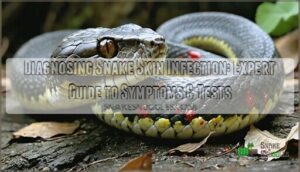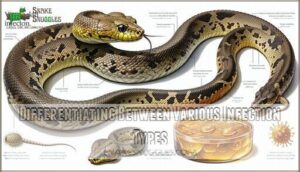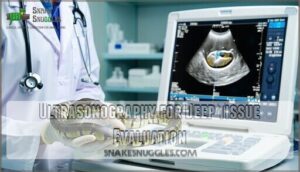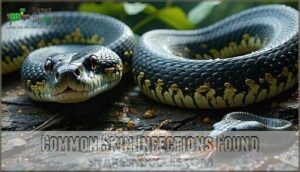This site is supported by our readers. We may earn a commission, at no cost to you, if you purchase through links.

Your snake might show decreased appetite, lethargy, or excessive hiding behavior.
Visual examination reveals bacterial infections as wet, oozing sores, while fungal infections appear as dry, crusty patches.
Veterinarians use skin scrapings for microscopic analysis and may perform cultures to identify specific pathogens.
Advanced cases require histopathological examination of tissue samples.
Don’t confuse infections with normal shedding – infected areas remain inflamed between shed cycles.
The key lies in recognizing subtle early warning signs before serious complications develop, which is crucial for effective treatment and requires careful observation of your snake’s behavior and physical condition, including watching for serious complications.
Table Of Contents
- Key Takeaways
- Snake Skin Infection Signs
- Diagnostic Techniques Used
- Advanced Imaging Methods
- Differential Diagnosis Process
- Common Skin Infections Found
- Frequently Asked Questions (FAQs)
- What does a skin infection look like on a snake?
- How to tell if a snake has an infection?
- What is snake skin diagnosis?
- How do you test for snake fungal disease?
- How do you treat a snake infection?
- What to do if your snake has a respiratory infection?
- What antibiotics are used for snake respiratory infections?
- How do you treat a reptile infection?
- How long does recovery from viral infections take?
- How much does snake skin infection treatment cost?
- Conclusion
Key Takeaways
- You’ll identify infections through visual cues – Look for red, inflamed areas with blisters on belly scales, plus behavioral changes like decreased appetite and lethargy.
- You can’t rely on surface examination alone – Proper diagnosis requires skin scrapings, microscopic analysis, and cultures to identify specific bacterial, fungal, or viral pathogens.
- You must distinguish infections from normal shedding – Infected areas stay inflamed between shed cycles, unlike normal ecdysis, where skin comes off cleanly in one piece.
- You need professional veterinary assessment – Early detection through regular monitoring improves outcomes, but accurate pathogen identification requires specialized testing and prescription treatments.
Snake Skin Infection Signs
When examining your snake for skin infections, you’ll need to look for specific visual and behavioral indicators that signal potential health problems.
Recognizing these early warning signs can make the difference between successful treatment and serious complications that threaten your snake’s wellbeing.
Visual Signs of Bacterial Infections
You’ll spot bacterial infections through several telltale visual cues.
Bacterial infections reveal themselves through distinctive visual markers that experienced snake keepers learn to spot quickly.
Look for circular, yellow-brown ulcers oozing fluid along the ventral scales. Scale damage appears as lifting or loosening with dull, opaque surfaces.
Skin lesions show distinct margins between healthy and diseased tissue. Bacterial symptoms include purulent exudate with foul odor, while infection signs manifest as redness, swelling, and crusted formations.
Identifying Fungal Infection Symptoms
You’ll notice fungal skin infections appear as distinctive white, gray, or yellow patches on your snake’s scales.
These Fungal Signs often present as raised, crusty lesions with irregular borders, unlike the smooth patterns of bacterial infections.
Diagnostic Tests require skin scraping for microscopic examination, revealing branching fungal hyphae.
Symptom Analysis shows these Infection Types typically affect multiple body segments simultaneously, creating characteristic "cotton-like" appearances that distinguish fungal infections from other reptile skin diseases.
Behavioral Changes Indicating Skin Problems
Infected snakes often exhibit reduced activity levels and decreased feeding responses, which can signal underlying skin infection symptoms.
When reptile skin disease develops, you’ll observe changes that go beyond surface-level skin lesions.
Key behavioral alerts include:
- Lethargy Signs – Extended periods of inactivity and reluctance to move
- Appetite Loss – Refusing food or showing disinterest in regular meals
- Shedding Patterns – Irregular or incomplete shed cycles indicating compromised skin health
These behavioral changes accompany physical symptoms during snake skin infection diagnosis, helping you identify problems before they worsen.
Differentiating Between Various Infection Types
Bacterial infections typically produce purulent discharge and ulcerative lesions, while fungal symptoms include thickened, crusty scales with yellowish-brown discoloration.
Parasitic skin conditions present as moving specks with scattered scale loss.
Viral infections create blistering without pus formation.
Laboratory culture confirms bacterial causes, microscopic examination identifies fungal organisms, and PCR testing detects viral pathogens when diagnostic challenges arise, using laboratory culture to aid in diagnosis.
Progressive Stages of Snake Skin Infections
Snake skin infections don’t appear overnight—they develop through predictable infection stages that you can learn to recognize.
Understanding disease progression helps improve your diagnostic challenges and treatment timing.
Here’s how snake skin infections typically advance:
- Initial Stage: Small, localized skin lesions appear as discolored patches or minor swelling
- Early Progression: Infection patterns spread to adjacent scales with increased inflammation
- Moderate Stage: Reptile skin lesions become raised, crusty, or ulcerated with possible discharge
- Advanced Stage: Systemic involvement affects appetite, behavior, and shedding cycles
- Severe Stage: Deep tissue damage occurs, requiring immediate veterinary intervention
Reptile dermatology shows that early intervention prevents complications.
Snake dermatology experts note that skin infection diagnosis becomes more challenging as infections progress, making early recognition essential for successful treatment outcomes.
Diagnostic Techniques Used
When you suspect your snake has a skin infection, proper diagnostic techniques help you identify the specific pathogen and develop an effective treatment plan.
Your veterinarian will use several methods ranging from simple visual assessments to advanced laboratory analyses to reach an accurate diagnosis.
Physical Examination and Visual Assessment
Your hands-on examination starts with systematic skin inspection of your snake’s entire body.
Look for color changes, pattern abnormalities, and texture evaluation that signal trouble.
Scale analysis reveals snake skin lesions appearing as discolored patches, raised bumps, or rough areas.
Reptile skin lesions often show irregular borders and altered surface texture compared to healthy scales surrounding them.
Accurate diagnosis may involve advanced skin scanning tools to detect underlying issues.
Skin Scraping and Microscopic Analysis
Precision becomes your greatest ally when collecting samples from snake skin lesions. You’ll need to carefully scrape affected areas using sterile techniques to gather cellular material for thorough microscopic analysis.
- Sterile scalpel blades – Essential diagnostic tools for gentle tissue sampling
- Glass slides preparation – Critical for proper cell analysis and examination
- Microscope techniques – Reveal bacterial, fungal, or parasitic organisms in samples
- Staining protocols – Enhance visibility of pathogens during tissue examination
This skin sampling approach helps identify specific pathogens causing reptile dermatology issues, guiding targeted treatment decisions. The use of high-quality surgical blade supplies is vital for accurate diagnostic results.
Histopathological Examination of Skin Samples
While skin scraping provides surface-level insights, tissue analysis through skin biopsy offers deeper diagnostic clarity.
Histopathology techniques examine cellular structures within infected tissue, revealing specific pathogen patterns invisible to standard microscopic exam.
This cellular diagnosis method identifies bacterial versus fungal infections by analyzing tissue architecture and inflammatory responses.
Dermatology specialists use these histology techniques to definitively diagnose snake skin problems when surface examination proves inconclusive, utilizing histopathology for accurate diagnosis.
Fungal Culture and Identification Methods
Whether collecting samples from snake scale infection sites or examining skin lesion diagnosis materials, fungal culture remains your most reliable diagnostic tool.
You’ll need specialized culture media to isolate organisms from reptile skin health specimens effectively.
- Sabouraud’s dextrose agar – Standard fungal isolation medium for most snake pathogens
- Potato dextrose agar – Enhanced growth medium for difficult-to-culture fungi species
- Dermatophyte test medium – Color-changing indicator for rapid fungi identification screening
- Microscopic examination – Direct visualization of fungal elements using KOH preparations
- Molecular testing – PCR-based microbial testing for precise laboratory diagnosis confirmation
Understanding reptile fungal infections is essential for effective diagnosis and treatment of snake skin infections.
Advanced Imaging Methods
When you need to see beyond surface symptoms, advanced imaging methods reveal what physical examination can’t detect.
These cutting-edge tools help you pinpoint infections hiding in deeper tissue layers and identify complications that might otherwise go unnoticed, using cutting-edge tools to aid in the process.
Ultrasonography for Deep Tissue Evaluation
Ultrasonography revolutionizes snake scale infection diagnosis through non-invasive tissue imaging.
High-frequency sonic waves penetrate beneath visible symptoms, revealing hidden abscesses and fluid collections.
This ultrasound tech enables real-time tissue analysis without anesthesia, making deep scanning safer for stressed reptiles.
You’ll detect subcutaneous changes invisible during standard examination, guiding targeted treatment decisions effectively.
Accurate diagnosis often relies on understanding skin infection causes to develop effective treatment plans, which is crucial for effective treatment and involves real-time tissue analysis and targeted treatment decisions to address skin infection causes.
Radiography to Detect Underlying Issues
X-ray imaging provides valuable insights when surface examination isn’t enough.
Radiographic analysis reveals bone abnormalities, foreign objects, or internal complications that might contribute to your snake’s skin problems. This diagnostic imaging technique helps veterinarians rule out underlying skeletal issues or detect retained shed material.
- Bone infections – Medical radiology can identify osteomyelitis affecting vertebrae or ribs
- Foreign body detection – Radiography locates embedded substrate or cage materials
- Retained shed identification – X-rays reveal stuck skin around tail tips or eye caps
- Systemic disease markers – Diagnostic techniques show organ enlargement or fluid accumulation
CT Scanning for Comprehensive Assessment
CT scanning provides thorough three-dimensional visualization of snake skin infection pathology.
Advanced CT imaging reveals deep tissue involvement and infection extent that surface examination misses.
Scan techniques detect abscess formation, bone involvement, and systemic spread.
Image analysis enables precise measurement of affected areas, while diagnostic accuracy improves treatment planning.
Medical imaging through CT scanning offers veterinarians detailed infection diagnosis capabilities beyond traditional methods, providing a basis for improved treatment planning.
Thermal Imaging in Infection Detection
Thermal imaging technology offers a non-invasive approach to infection detection in snakes.
Infrared scanning reveals temperature variations across the skin surface, where infected areas typically show elevated heat signatures compared to healthy tissue.
Thermal cameras capture these heat patterns, allowing veterinarians to identify inflammation before visible symptoms appear.
Detection systems analyze thermal data to pinpoint infection locations accurately.
Veterinarians may find the thermal scanner availability helpful, using thermal imaging for precise detection, and it is a valuable tool for infection detection.
Differential Diagnosis Process
When you’re diagnosing snake skin issues, you’ll need to distinguish between actual infections and normal biological processes like shedding problems.
Your systematic approach should rule out non-infectious causes, trauma, genetic disorders, and systemic diseases that can mimic skin infections, to ensure that you’re addressing the actual issue, which could be related to shedding problems.
Distinguishing Infections From Shedding Issues
Normal shedding creates predictable patterns you can recognize easily. During healthy ecdysis, snakes develop milky eyes and dull skin before shedding completely in one piece.
However, shedding complications like scale retention or dysecdysis causes irregular patches that mimic infection symptoms. When diagnosing snake skin conditions, look for retained shed pieces versus actual lesions.
Infection mimicry occurs when old skin creates false alarm signs, which can be confused with actual lesions.
Identifying Non-Infectious Skin Abnormalities
Looking beyond infections, you’ll encounter various non-infectious snake skin issues requiring careful diagnosis.
Thermal burns create distinctive patterns from heat sources, while scar tissue forms raised, discolored areas from previous injuries.
Genetic defects produce scale deformities that appear symmetrical and consistent, and shedding problems cause retained skin patches, unlike infectious lesions.
These snake skin conditions need different treatments than infections, making accurate identification essential for proper snake skin health management, and proper snake skin health is crucial for the well-being of the snake, with accurate identification being key, and different treatments are necessary.
Evaluating Systemic Diseases With Skin Manifestations
Beyond simple surface infections, you’ll need to recognize when skin lesions signal deeper health problems.
Snake skin infection often masks underlying systemic diseases that require different treatment approaches.
Diagnostic markers help distinguish between localized skin issues and widespread illness affecting multiple organ systems.
- Ophidiomycosis – Thickened, crusted skin with respiratory symptoms
- Inclusion Body Disease – Skin blistering plus neurological signs
- Septicemia – Skin ulcers with lethargy and organ involvement
- Renal disease – Yellow, ulcerated skin from metabolic waste buildup
Disease progression patterns reveal whether you’re dealing with skin pathology alone or systemic conditions requiring thorough reptile skin care protocols.
Assessing Traumatic Skin Injuries in Snakes
Traumatic skin injuries require careful assessment to distinguish them from infectious conditions in reptile health.
Fresh wounds show clean edges and bleeding, while infected trauma presents with purulent discharge and surrounding inflammation.
You’ll need diagnostic tools like magnification and gentle probing to evaluate wound healing progress.
Proper trauma care involves cleaning debris and monitoring for secondary skin infection development.
Document lesion characteristics, location, and any visible foreign material.
Unlike infections, traumatic skin lesions typically show linear patterns or puncture marks consistent with injury mechanisms in snake skin care protocols, which is crucial for proper trauma care and understanding wound healing.
Ruling Out Genetic Skin Disorders
Genetic skin disorders represent inherited conditions that can mimic infectious processes in snakes.
You’ll need to examine the snake’s lineage and breeding history to identify hereditary traits that affect skin development and appearance.
Key genetic assessment steps:
- Genetic Testing – DNA analysis reveals specific mutations causing abnormal skin formation patterns
- Skin Biopsy – Histological examination shows characteristic cellular structures indicating genetic abnormalities
- Inheritance Patterns – Review breeding records to track dominant or recessive trait transmission
- Diagnostic Markers – Identify specific protein expressions that distinguish genetic from infectious conditions
Proper snake skin care involves recognizing that some skin disorders aren’t infections requiring antimicrobial treatment, but genetic variations needing supportive management through veterinary dermatology expertise.
Understanding skin health issues is essential for effective diagnosis and treatment of genetic skin disorders in snakes.
Common Skin Infections Found
You’ll encounter several distinct types of skin infections when examining snakes, each requiring specific diagnostic approaches and treatment protocols.
Understanding these common conditions helps you provide accurate diagnoses and effective care for your reptilian patients, which is crucial for their health and well-being, and requires a good understanding of complete concepts.
Bacterial Dermatitis in Snakes
Bacterial dermatitis represents the most common Snake Health concern you’ll encounter.
These infections typically start when bacteria breach damaged skin, creating distinctive lesions that differ from fungal conditions.
Bacterial Signs include reddened scales, pustules, and necrotic tissue patches.
| Early Stage | Advanced Stage |
|---|---|
| Scale discoloration | Deep tissue necrosis |
| Mild swelling | Purulent discharge |
| Localized redness | Systemic illness |
| Surface erosion | Scale loss |
Infection Control requires identifying Dermatitis Causes like poor hygiene, trauma, or stress.
Unlike snake bite infection, bacterial skin infection spreads gradually across body segments.
Proper Reptile Care prevents most cases, while skin infection treatment addresses existing reptile infections effectively.
Snake Fungal Disease (SFD)
Snake Fungal Disease (SFD) represents a serious threat you’ll encounter when diagnosing snake diseases.
Caused by Ophidiomyces ophidiicola, this fungal infection affects over 36 wild snake species across North America.
You’ll identify SFD through characteristic crusty scales, facial swelling, and abnormal shedding patterns.
Proper diagnosing requires PCR testing and fungal culture for accurate identification, making fungal treatment challenging in reptile infections.
Viral Skin Infections in Reptiles
Unlike bacterial or fungal problems, viral infections in reptiles present unique diagnostic challenges.
You’ll notice skin lesions that appear as raised bumps, discolored patches, or unusual growths on your snake’s surface.
Diagnostic tests for viral loads require specialized laboratory analysis, making early detection essential.
Proper reptile care and infection control measures help prevent these infections from spreading to other animals in your collection.
Understanding the risks of viral infection signs is essential for effective prevention and treatment strategies.
Parasitic Skin Conditions in Snakes
Parasitic infections create distinctive skin lesions that you’ll notice during routine reptile health assessments.
Mites appear as tiny moving dots between scales, while ticks attach firmly to soft tissue areas.
These snake parasites cause intense irritation, leading to excessive rubbing and secondary bacterial infections.
You’ll observe red, inflamed patches where parasites feed, often accompanied by scale damage.
Effective infection control requires immediate veterinary care and thorough habitat cleaning to prevent reinfestations.
Environmental Factors Contributing to Skin Infections
Environmental factors create the perfect storm for parasitic skin infections in your snake.
Poor husbandry weakens their natural defenses, making infection symptoms more likely.
Key environmental contributors include:
- Humidity Levels – Excessive moisture (>70%) promotes fungal growth and skin inflammation
- Temperature Control – Unstable temps disrupt shedding, creating entry points for microbial infections
- Water Quality – Contaminated bowls harbor bacteria causing zoonotic diseases
- Substrate Sanitation – Dirty bedding increases pathogen load and infection risk
Lighting Effects also influence immune function and healing rates.
Frequently Asked Questions (FAQs)
What does a skin infection look like on a snake?
You’ll notice that roughly 80% of infected snakes develop visible blisters, crusts, ulcers, or discolored scales on their skin.
These lesions typically appear on ventral scales, accompanied by increased shedding frequency and potential swelling or pus discharge in advanced cases, which can be considered a key lesions development.
How to tell if a snake has an infection?
Look for visible skin changes like blisters, crusts, ulcers, or unusual discoloration on your snake’s scales.
Watch for increased shedding problems, lethargy, decreased appetite, and any swelling or discharge around affected areas, which can indicate a serious issue requiring immediate veterinary attention.
What is snake skin diagnosis?
Ever wondered how vets identify skin problems in your scaly friend?
Snake skin diagnosis involves examining visual symptoms like discolored scales, blisters, or abnormal shedding patterns.
You’ll observe lesions, swelling, and behavioral changes to determine infection type and severity, which is crucial for accurate diagnosis.
How do you test for snake fungal disease?
You’ll need a veterinary examination with skin scrapings, fungal cultures, and sometimes biopsy samples.
PCR testing can identify specific fungal DNA. Your vet might also use cytology to examine cells under a microscope for fungal elements.
How do you treat a snake infection?
Treating snake infections isn’t rocket science, but you’ll need proper veterinary care first. Topical antifungals, systemic medications, and environmental improvements typically clear infections effectively when prescribed correctly.
What to do if your snake has a respiratory infection?
Contact your reptile veterinarian immediately for proper diagnosis and treatment.
Respiratory infections in snakes require prescription antibiotics and professional medical care.
Don’t attempt home remedies – these infections can quickly become life-threatening without veterinary intervention.
What antibiotics are used for snake respiratory infections?
While skin conditions require topical care.
Respiratory infections demand swift antibiotic intervention. You’ll need enrofloxacin (Baytril) or ceftazidime injections from your exotic vet—these target bacterial culprits effectively, restoring your snake’s breathing, with antibiotic intervention being crucial.
How do you treat a reptile infection?
You’ll need a veterinarian’s examination for proper diagnosis and prescription antibiotics.
Treatment typically involves injectable medications, supportive care including fluid therapy, environmental adjustments for ideal temperature and humidity.
Plus addressing underlying husbandry issues causing stress.
How long does recovery from viral infections take?
Like a storm cloud passing overhead, viral recovery timelines vary widely.
You’ll typically see improvement within 7-14 days for mild infections, though severe cases may take several weeks.
Your immune system’s strength and the specific virus determine healing speed.
How much does snake skin infection treatment cost?
Snake skin infection treatment costs vary widely, typically ranging from $50-300 for veterinary visits, medications, and follow-up care.
You’ll need professional diagnosis since topical treatments require prescription antifungals or antibiotics depending on the specific pathogen involved.
Conclusion
Prevention remains the best medicine when diagnosing snake skin infection effectively.
Early detection through regular visual examination and behavioral monitoring substantially improves treatment outcomes.
You’ll need professional veterinary assessment for accurate pathogen identification through skin scrapings, cultures, and histopathological analysis.
Don’t delay seeking expert help when you notice concerning symptoms.
Proper husbandry practices, including ideal temperature, humidity, and cleanliness, prevent most infections.
Quick action protects your snake’s health and guarantees successful recovery from skin conditions, which is why early detection and proper husbandry are crucial for the health of your snake.
- https://docs.google.com/forms/d/1GAQr3Kn1cURCVHUA82hAga1Wv8DCH0IuqDLRUrOpN7M/viewform?ts=63f4f653&entry.1515682415=https://www.merriam-webster.com/dictionary%2Fdiagnose
- https://www.merriam-webster.com/dictionary/diagnosis
- https://www.freethesaurus.com/diagnosing
- https://medical-dictionary.thefreedictionary.com/diagnosing
- https://premium.britannica.com/mw-unabridged/?utm_source=mw&utm_medium=inline-def&utm_campaign=evergreen


















